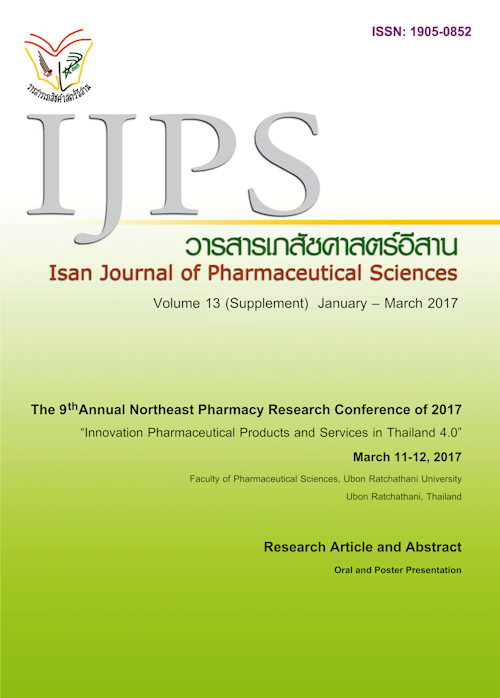Comparison of Vesicle Formulations for Transdermal Delivery of Curcumin: Liposomes, Flexosomes and Invasomes
Main Article Content
Abstract
Introduction: For the past four decades, liposomes have been developed as transdermal delivery carriers in various drugs. There are several vesicle types, including transfersomes, ethosomes, flexosomes, invasomes, menthosomes and transinvasomes. The intrinsic properties of these vesicles depended on their compositions. The aim of this study was to design and develop the different vesicle formulations for the transdermal delivery of curcumin. Methods: Curcumin loaded vesicles containing a controlled amount of phospholipid, cholesterol, curcumin and various amounts of penetration enhancers (Tween 20 and terpene) were prepared by using a sonication method. The physicochemical characteristics of vesicle formulations (e.g., vesicle size, size distribution, zeta potential and entrapment efficiency) were investigated. The effect of penetration enhancers on the intercellular lipid microstructure was also determined by the Fourier transform infrared spectroscopy (FTIR) and differential scanning calorimetry (DSC). Results: The vesicle size of all formulations was below 50 nm with narrow size distribution and negative zeta potential. The entrapment efficiency of flexosomes and invasomes was significantly higher than what is found in conventional liposomes. FTIR-spectra and DSC thermogram indicated that the penetration enhancers might result in the fluidity of the skin. Conclusion: These results indicated that Tween 20 and terpene affected the physicochemical characteristics of the vesicle formulations. Flexosomes and invasomes are the optimal vesicle formulations that may be used as transdermal delivery carriers for curcumin.
Article Details
In the case that some parts are used by others The author must Confirm that obtaining permission to use some of the original authors. And must attach evidence That the permission has been included
References
Agrawal R, Sandhu SK, Sharma I, Kaur IP, Development and Evaluation of Curcumin-loaded Elastic Vesicles as an Effective Topical Anti-inflammatory Formulation. AAPS PharmSciTech.2015; 16(2): 364-374.
Badran M, Shazly GA, EL-Badry M, Effect of terpene liposomes on the transdermal delivery of hydrophobic model drug, nimesulide: Characterization, stability and in vitro skin permeation. Afr J Pharm Pharmacol. 2012; 6(43): 3018-3026.
Bernabe-Pineda M, Ramirez-Silva MT, Romero-Romo M, Gonzalez-Vergara E, Rojas-Hernandez A, Determination of acidity constants of curcumin in aqueous solution and apparent rate constant of its decomposition. Spectrochim Acta A Mol Biomol Spectrosc. 2004; 60(5): 1091-1097.
Chaudhary H, Kohli K, Kumar V, Nano-transfersomes as a novel carrier for transdermal delivery. Int J Pharm.2013; 454(1): 367-380.
Chen Y, Wu Q, Zhang Z, Yuan L, Liu X, Zhou L, Preparation of curcumin-loaded
liposomes and evaluation of their skin permeation and pharmacodynamics. Molecules. 2012; 17(5): 5972-5987.
Dragicevic-Curic N, Scheglmann D, Albrecht V, Fahr A, Temoporfin-loaded invasomes: development, characterization and in vitro skin penetration studies. J Control Release. 2008; 127(1): 59-69.
Duangjit S, Nimcharoenwan T, Chomya N, Locharoenrat N, Ngawhirunpat T, Computational design strategy: an approach to enhancing the transdermal delivery of optimal capsaicin-loaded transinvasomes. Drug Dev Ind Pharm.2017; 43(1): 98-107.
Duangjit S, Opanasopit P, Rojanarata T, Takayama J, Takayama K, Ngawhirunpat T, Bootstrap resampling technique to evaluate the reliability of the optimal liposome formulation: skin permeability and stability response variables. Biol Pharm Bull. 2014; 37(9): 1543-1549.
Gillet A, Compere P, Lecomte F, Hubert P, Ducat E, Evrard B, et al., Liposome surface charge influence on skin penetration behaviour. Int J Pharm. 2011; 411(1-2): 223-231.
Hatcher H, Planalp R, Cho J, Torti FM, Torti SV, Curcumin: from ancient medicine to current clinical trials. Cell Mol Life Sci. 2008; 65(11): 1631-1652.
Lachenmeier DW, Safety evaluation of topical applications of ethanol on the skin and inside the oral cavity. J Occup Med Toxicol. 2008; 3: 26-26.
Naksuriya O, Okonogi S, Schiffelers RM, Hennink WE, Curcumin nanoformulations: a review of pharmaceutical properties and preclinical studies and clinical data related to cancer treatment. Biomaterials. 2014; 35(10): 3365-3383.
Ogiso T, Yamaguchi T, Iwaki M, Tanino T, Miyake Y, Effect of positively and negatively charged liposomes on skin permeation of drugs. J Drug Target.2001; 9(1): 49-59.
Prasanthi D, Lakshmi PK, Iontophoretic Transdermal Delivery of Finasteride in Vesicular Invasomal Carriers. Pharm Nanotechnol. 2013; 1(2): 136-150.
Raffy S, Teissié J, Control of lipid membrane stability by cholesterol content. Biophysical Journal. 1999; 76(4): 2072-2080.
Subongkot T, Duangjit S, Rojanarata T, Opanasopit P, Ngawhirunpat T, Ultradeformable liposomes with terpenes for delivery of hydrophilic compound. J Liposome Res. 2012; 22(3): 254-262.
Verma DD, Verma S, Blume G, Fahr A, Particle size of liposomes influences dermal delivery of substances into skin. Int J Pharm. 2003; 258(1-2): 141-151.
Wilhelm KP, Freitag G, Wolff HH, Surfactant-induced skin irritation and skin repair. Evaluation of the acute human irritation model by noninvasive techniques. J Am Acad Dermatol. 1994; 30(6): 944-949.
Zhao YZ, Lu CT, Zhang Y, Xiao J, Zhao YP, Tian JL, et al., Selection of high efficient transdermal lipid vesicle for curcumin skin delivery. Int J Pharm.2013; 454(1): 302-309.


